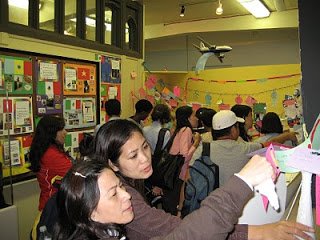
Continuing to build on the AAM forecasting report Demographic Transformation and the Future of Museums, this week’s guest post is contributed by Elizabeth Stewart, director of the Renton History Museum in Renton, Washington.
A recent series of posts (see here and here) on the CFM blog, as well as the CFM report Demographic Transformation and the Future of Museums, encouraged me to share one of the Renton History Museum’s own efforts to reach out to our community. When an opportunity presented itself to collaborate with the local community college’s English as a Second Language (ESL) program, we were ready to take advantage of it. The result has been a very popular annual summer exhibit of art and writing projects by ESL students that has brought ethnic communities, the college, the museum and the wider community together.
As staff of a small local history museum with limited resources, we often feel intimidated by the challenges facing museums, the increasing ethnic diversity of our community being one of the most significant. Five years ago we acknowledged to ourselves that, with over 80 languages spoken in our local school district, the Renton History Museum’s exhibits and collections did not reflect our community. A dedicated group of white middle-class educators and librarians founded the museum in the 1970s, but that generation is now passing from the scene. Like small history museums around the country, we understand that ensuring the Museum’s future sustainability and relevancy—not to mention living up to our mission—requires change.
In 2006 Renton Technical College inaugurated an International Fair (later renamed the CommUNITY Festival) to showcase the college’s diverse student body and their accomplishments. The college represents an important transitional organization for new residents of the region. 36% of RTC students are enrolled in ESL classes; these students come from 57 countries and speak 45 different languages. The annual CommUNITY Festival, held on campus, gives ESL students an opportunity to participate in musical performances and a fashion show, share foods from around the world and display art and writing projects about their home countries and their experiences in the U.S. 
The festival tends to be oriented toward students and their families, however; museum staff saw an opportunity both to bring ESL students’ experiences to a wider audience while inviting this ethnically diverse group, already organized by the college, to contribute content to the museum. Since 2006 the Renton History Museum has worked with administrators of the ESL program to bring a selection of student work into the museum for exhibit for 6 – 8 weeks every summer. Renton History Museum Education Coordinator Dorota Rahn works with Renton Technical College Curriculum and Technology Specialist Jenna Pollock throughout the year to suggest possible exhibit themes for instructors to shape to their needs. Instructors and students welcome the chance to work on issues relevant to the wider community. In 2009, for example, in conjunction with the Museum’s hosting the SITES exhibit Key Ingredients: America By Food, ESL students created projects ranging from a poster exhibit about food-related colloquialisms from other languages to a serious documentary piece by several students about holding down jobs in a fish-packing plant in nearby Seattle. Museum staff are minimally involved in the “curation” of the exhibit, preferring to stand aside and let the students’ work speak for itself, unmediated by any authoritative voice.
Now in its fifth year, the annual ESL exhibit has become an important way that the Museum addresses our responsibility to document and interpret Renton’s history in all its diversity. The exhibit opening is always our most well-attended reception, with ESL instructors, students and administrators, as well as dignitaries and museum members. Although this small effort has not yet resulted in changes to our collection, we have seen both our roster of volunteers and our visitors become more diverse, as word gets out that the Museum is a welcoming place.
Not only do these exhibits further our own internal strategic goals, for our typical group of white middle-class visitors the exhibits humanize “immigrants,” a group often demonized in media coverage, by conveying—in their own words—the complexity of their experiences, their aspirations, and their striving to build lives for themselves and their families in the U.S. While this collaboration represents a small step in a much longer process, we have found a successful way to draw together our increasingly diverse community.
Do you have stories to share about how your museum cultivates diverse audiences? Write me at futureofmuseums@aam-us.org to share your experiences with the field.








